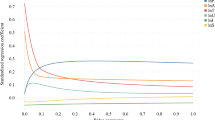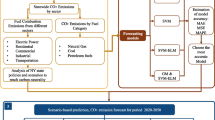Abstract
De-carbonization of the transport sector is an important pathway to climate-change mitigation and presents the potential for future lower emissions. To assess the potential quantitatively under different optimization measures, this paper presents a hybrid model combining an integrated machine learning model with the scenario analysis. We compare the training accuracy of the back-propagation neural networks (BPNN), Gaussian process regression (GPR), and support vector machine (SVM) fitting model with different training datasets. The results indicate that the performance of the SVM model is superior to other methods. And the particle swarm optimization (PSO) algorithm is then used to optimize hyper-parameters of the SVM model. Two scenarios including business as usual (BAU) and best case (BC) are set according to the current trends and target trends of driving factors identified by the extended stochastic impacts by regression on population, affluence, and technology (STIRPAT) model. Finally, to find the de-carbonization potentials in the transport sector, the PSO-SVM model is applied to predict transport emissions from 2015 to 2030 under two scenarios. Results show that transport emissions reduce by about 131.36 million tons during 2015–2020 and 372.86 million tons during 2021–2025 in the BC scenario. The findings can effectively track, test, and predict the achievement of policy goals and provide practical guidance for de-carbonization development.











Similar content being viewed by others
References
Abdi MJ, Giveki D (2013) Automatic detection of erythemato-squamous diseases using PSO–SVM based on association rules. Eng Appl Artif Intell 26(1):603–608
Andrés L, Padilla E (2018) Driving factors of GHG emissions in the EU transport activity. Transp Policy 61:60–74
Atlas GC (2016) CO2 emissions. http://www.globalcarbonatlas.org/en/CO2-emissions. Accessed 10 Oct 2018
Baareh AK (2013) Solving the carbon dioxide emission estimation problem: an artificial neural network model. J Softw Eng Appl 6(07):338
Brødsgaard (2016) China’s 13th five-year Plan: a draft Proposal. The Copenhagen Journal of Asian Studies 33(2):97–105
Bueno G (2012) Analysis of scenarios for the reduction of energy consumption and GHG emissions in transport in the Basque Country. Renew Sust Energ Rev 16(4):1988–1998
Chen TD, Kockelman KM (2016) Carsharing’s life-cycle impacts on energy use and greenhouse gas emissions. Transp Res Part D: Transp Environ 47:276–284
Cleghorn CW, Engelbrecht AP (2015) Particle swarm variants: standardized convergence analysis. Swarm Intell 9(2–3):177–203
Cortes C, Vapnik V (1995) Support-vector networks. Mach Learn 20(3):273–297
Cuda P, Dincer I, Naterer GF (2012) Hydrogen utilization in various transportation modes with emissions comparisons for Ontario, Canada. Int J Hydrog Energy 37(1):634–643
Davis SJ, Caldeira K, Matthews HD (2010) Future CO2 emissions and climate change from existing energy infrastructure. Science 329(5997):1330–1333
Debin F, Bo D (2015) Prediction of China’s carbon emission trend during thirteenth five-year development planning based on GPR model. Technol Econ 6:016
Dietz T, Rosa EA (1994) Rethinking the environmental impacts of population, affluence and technology. Hum Ecol Rev 1(2):277–300
Du J, Liu Y, Yu Y, Yan W (2017) A prediction of precipitation data based on support vector machine and particle swarm optimization (PSO-SVM) algorithms. Algorithms 10(2):57
Eberhart R, Kennedy J (1995) A new optimizer using particle swarm theory. In: micro machine and human science MHS'95, proceedings of the sixth international symposium on IEEE 39-43
Eggleston S, Buendia L, Miwa K (2006) IPCC guidelines for national greenhouse gas inventories [recurso electrónico]: waste. Institute for Global Environmental Strategies, Kanagawa
Ehmke JF, Campbell AM, Thomas BW (2016) Vehicle routing to minimize time-dependent emissions in urban areas. Eur J Oper Res 251(2):478–494
Ehrlich PR, Holdren JP (1971) Impact of population growth. Science 171(3977):1212–1217
Elbisy MS (2013) Sea wave parameters prediction by support vector machine using a genetic algorithm. J Coast Res 31(4):892–899
Fan F, Lei Y (2016) Decomposition analysis of energy-related carbon emissions from the transportation sector in Beijing. Transp Res Part D: Transp Environ 42:135–145
Fang D, Zhang X, Yu Q, Jin TC, Tian L (2018) A novel method for carbon dioxide emission forecasting based on improved Gaussian processes regression. J Clean Prod 173:143–150
Fletcher T (2009) Support vector machines explained: introductory course. Technical Internal Report, University College London (UCL), London, UK, pp. 10–15
Gao L, Bryan BA (2017) Finding pathways to national-scale land-sector sustainability. Nature 544(7649):217–222
Guo D, Chen H, Long R (2018) Can China fulfill its commitment to reducing carbon dioxide emissions in the Paris agreement? Analysis based on a back-propagation neural network. Environ Sci Pollut Res 25:27451–27462 1-12
Hertwich EG, Gibon T, Bouman EA, Arvesen A, Suh S, Heath GA, Bergesen JD, Ramirez A, Vega MI, Shi L (2015) Integrated life-cycle assessment of electricity-supply scenarios confirms global environmental benefit of low-carbon technologies. Proc Natl Acad Sci 112(20):6277–6282
Kaewunruen S, Sussman JM, Einstein HH (2015) Strategic framework to achieve carbon-efficient construction and maintenance of railway infrastructure systems. Front Environ Sci 3:6
Kahn H, Wiener AJ (1967) A framework for speculation on the next thirty-three years. Macmillan, New York
Kishita Y, Ohishi Y, Uwasu M, Kuroda M, Takeda H, Hara K (2016) Evaluating the life cycle CO2 emissions and costs of thermoelectric generators for passenger automobiles: a scenario analysis. J Clean Prod 126:607–619
Kwon TH (2005) Decomposition of factors determining the trend of CO2 emissions from car travel in Great Britain (1970–2000). Ecol Econ 53(2):261–275
Lakshmanan TR, Han X (1997) Factors underlying transportation CO2 emissions in the USA: a decomposition analysis. Transp Res Part D: Transp Environ 2(1):1–15
Li W, Li H, Zhang H, Sun S (2016) The analysis of CO2 emissions and reduction potential in China’s transport sector. Math Probl Eng. https://doi.org/10.1155/2016/1043717
Li X, Fan Y, Wu L (2017) CO2 emissions and expansion of railway, road, airline and in-land waterway networks over the 1985–2013 period in China: a time series analysis. Transp Res Part D: Transp Environ 57:130–140
Liu Z, Qin CX, Zhang YJ (2016) The energy-environment efficiency of road and railway sectors in China: evidence from the provincial level. Ecol Indic 69:559–570
Liu X, Zhou D, Zhou P, Wang Q (2017) Dynamic carbon emission performance of Chinese airlines: a global Malmquist index analysis. J Air Transp Manag 65:99–109
Miller TR, Wiek A, Sarewitz D, Robinson J, Olsson L, Kriebel D, Loorbach D (2014) The future of sustainability science: a solutions-oriented research agenda. Sustain Sci 9(2):239–246
Morton C, Lovelace R, Anable J (2017) Exploring the effect of local transport policies on the adoption of low emission vehicles: evidence from the London congestion charge and hybrid electric vehicles. Transp Policy 60:34–46
O'Mahony T (2013) Decomposition of Ireland's carbon emissions from 1990 to 2010: an extended Kaya identity. Energy Policy 59:573–581
Raskin P, Gallopin G, Gutman P, Hammond A, Swart R (1998) Bending the curve: toward global sustainability. Division of Environmental Information, Assessment and Early Warning, United Nations Environment Programme
Raskin PD, Electris C, Rosen RA (2010) The century ahead: searching for sustainability. Sustainability 2(8):2626–2651
Robinson JB (2007) Life in 2030: exploring a sustainable future for Canada. UBC Press, Vancouver
Safavi HR, Esmikhani M (2013) Conjunctive use of surface water and groundwater: application of support vector machines (SVMs) and genetic algorithms. Water Resour Manag 27(7):2623–2644
Sanz MT, Cansino JM, González-Limón JM, Santamaria M, Yñiguez R (2014) Economic assessment of CO2 emissions savings in Spain associated with the use of biofuels for the transport sector in 2010. Util Policy 29:25–32
Schandl H, Hatfield-Dodds S, Wiedmann T (2016) Decoupling global environmental pressure and economic growth: scenarios for energy use, materials use and carbon emissions. J Clean Prod 132:45–56
Schipper LJ, Marie-Lilliu C (1999) Carbon-dioxide emissions from transport in IEA countries: recent lessons and long-term challenges. KFB meddelande 11
Schwartz P (1991) The art of the Long view: paths to strategic insight for yourself and your company. Doubleday, New York
Steenhof P, Woudsma C, Sparling E (2006) Greenhouse gas emissions and the surface transport of freight in Canada. Transp Res Part D: Transp Environ 11(5):369–376
Su B, Ang BW (2012) Structural decomposition analysis applied to energy and emissions: some methodological developments. Energy Econ 34(1):177–188
Sun W, Liu M (2016) Prediction and analysis of the three major industries and residential consumption CO2 emissions based on least squares support vector machine in China. J Clean Prod 122:144–153
Swart RJ, Raskin P, Robinson J (2004) The problem of the future: sustainability science and scenario analysis. Glob Environ Chang 14(2):137–146
Taylor NB (2018) Inland Waterway Transport–Challenges and Prospects. Edited by Bart Wiegmans and Rob Konings,(Routledge, 221 pp). Journal of Transport Geography 69:307
Tian X, Geng Y, Zhong S, Wilson J, Gao C, Chen W, Yu Z, Hao H (2018) A bibliometric analysis on trends and characters of carbon emissions from transport sector. Transp Res Part D: Transp Environ 59:1–10
Timilsina GR, Shrestha A (2009) Transport sector CO2 emissions growth in Asia: underlying factors and policy options. Energy Policy 37(11):4523–4539
Torvanger A (1991) Manufacturing sector carbon dioxide emissions in nine OECD countries, 1973–1987: a Divisia index decomposition to changes in fuel mix, emission coefficients, industry structure, energy intensities and international structure. Energy Econ 13:168–186
United Nations (2015) Transforming our world: the 2030 agenda for sustainable development. https://sustainabledevelopment.un.org/post2015/transformingourworld, New York. Accessed 5 Nov 2018
Vapnik VN (2000) The nature of statistical learning theory, ser. Statistics for engineering and information science. Springer, New York, pp 1003–1008
Vapnik VN, Chervonenkis A Y. (2015) On the uniform convergence of relative frequencies of events to their probabilities. Measures of complexity, Springer, Cham, pp:11–30
Wack P (1985) Scenarios: uncharted waters ahead. Harvard Business Review. September–October
Wang WW, Zhang M, Zhou M (2011) Using LMDI method to analyze transport sector CO2 emissions in China. Energy 36(10):5909–5915
Wang H, Ou X, Zhang X (2017) Mode, technology, energy consumption, and resulting CO2 emissions in China's transport sector up to 2050. Energy Policy 109:719–733
World Bank Open Data (2015) https://data.worldbank.org/. Accessed 6 Oct 2018
Xie R, Fang J, Liu C (2017) The effects of transportation infrastructure on urban carbon emissions. Appl Energy 196:199–207
Xu B, Lin B (2015) Factors affecting carbon dioxide (CO2) emissions in China's transport sector: a dynamic nonparametric additive regression model. J Clean Prod 101:311–322
Yan X, Crookes RJ (2009) Reduction potentials of energy demand and GHG emissions in China's road transport sector. Energy Policy 37(2):658–668
Zhou C, Yin K, Cao Y, Ahmed B (2016) Application of time series analysis and PSO–SVM model in predicting the Bazimen landslide in the three gorges reservoir, China. Eng Geol 204:108–120
Zhou J, Yu X, Guang F, Li W (2018) Analyzing and predicting CO 2 emissions in China based on the LMDI and GA-SVM model. Pol J Environ Stud 27(2):927–938
Funding
This work was supported by the National Natural Science Foundation of China (NSFC) [Grant Numbers 71771067, 71390522, 71671053]; the National Key R&D Program of China [Grant Number 2016YFC0701800]; and the Tsinghua University Energy Internet Research Institute (EIRI) Seed Fund Program.
Author information
Authors and Affiliations
Corresponding author
Ethics declarations
Conflict of interest
The authors declare that they have no conflict of interest.
Additional information
Responsible Editor: Philippe Garrigues
Publisher’s note
Springer Nature remains neutral with regard to jurisdictional claims in published maps and institutional affiliations.
Appendix
Appendix
Rights and permissions
About this article
Cite this article
Wang, L., Xue, X., Zhao, Z. et al. Finding the de-carbonization potentials in the transport sector: application of scenario analysis with a hybrid prediction model. Environ Sci Pollut Res 27, 21762–21776 (2020). https://doi.org/10.1007/s11356-020-08627-1
Received:
Accepted:
Published:
Issue Date:
DOI: https://doi.org/10.1007/s11356-020-08627-1




